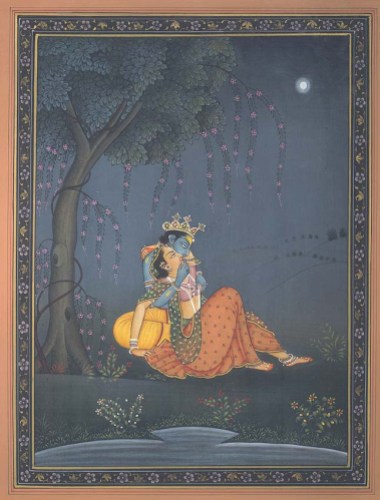Earlier treatises placed śṛngāra (love/the erotic) among the aesthetic qualities known as rasas, but the 11th-century Śṛngāraprakāśa, attributed to Bhojarāja, King of Malwa (inset), was the first to assert its supreme importance.
 The treatise includes highly detailed typologies of love—for example, chapter 22 alone discusses 64 stages of love, each subdivided into 8 categories, each of which is then subdivided into 8 more categories, with hundreds of illustrations from poetic works in Prakrit and Sanskrit.
The treatise includes highly detailed typologies of love—for example, chapter 22 alone discusses 64 stages of love, each subdivided into 8 categories, each of which is then subdivided into 8 more categories, with hundreds of illustrations from poetic works in Prakrit and Sanskrit.
This according to “Bhoja’s Sringara prakasa: A landmark in the evolution of rasa theory” by V. Subramaniam (Sruti 190 [July 2000] pp. 37–41). Above, a classic image of Krishna and Radha in the moonlight; below, the legendary T. Balasaraswati’s depiction of Krishna’s childhood provides an embodiment of śṛngāra in bharata nāṭyam (filmed by Satyajit Ray).




Pingback: Naṭarāja redux | Bibliolore